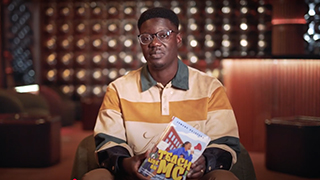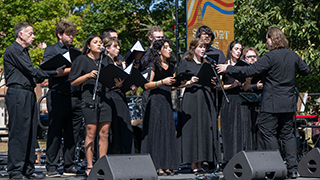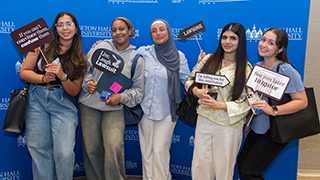Professor’s New Book Brings Hip-Hop Pedagogy to Classrooms Nationwide
Friday, May 2, 2025

Edmund Adjapong's new book, Teach Like an MC, guides using hip-hop culture to engage students, foster community, and enrich learning in K-12 classrooms.
Edmund Adjapong, Ph.D., associate professor of educational studies in the College of Human Development, Culture, and Media, has released a new book that seeks to transform the way teachers engage students. Teach Like an MC: Hip-Hop Pedagogy in the K–12 Classroom, published by Heinemann, offers a practical framework for integrating hip-hop culture into teaching — helping educators connect with students, build community, and deepen learning across subject areas.
“Teach Like an MC builds on over a decade of research and practice at the intersection of hip-hop and education,” said Adjapong. “It is an extension of my dissertation research and my practice as a 6th-grade science educator in the Bronx and offers a concrete, actionable framework for educators, whether they’re just starting or deeply rooted in using a hip-hop-informed framework in their practice.”
A Bronx native and former middle school science teacher in New York City public schools, Adjapong is also the director of Seton Hall’s Hip-Hop Culture, Equity, and Excellence Academy. His academic work explores the power of culturally sustaining pedagogy, with hip-hop at the center as a tool for building student voice and critical consciousness. He is the founding editor of the Journal of Hip-Hop Education and editor of the #HipHopEd Compilation Book Series.
As hip-hop pedagogy continues to gain momentum in education circles, Adjapong sees not only growing interest but also important opportunities to deepen understanding of hip-hop’s cultural richness and educational power. “I meet skepticism with conversation, context, and empathy,” he said. “A lot of resistance comes from misunderstanding what hip-hop truly is — its history, cultural significance, and power as a tool for learning that promotes social justice.”
Adjapong challenges the notion that hip-hop belongs only in music classes or after-school clubs. “Hip-hop isn’t just a genre of music but a global cultural phenomenon,” he said. “I highlight the idea that every person has a hip-hop identity, whether they engage with it consciously or not. It’s about meeting students where they are, and guiding them to use their voice and understanding of content to improve their local and global communities.”
The book shares real-world examples of how teachers are already applying hip-hop pedagogy in their classrooms — with striking results.
“I’ve seen high school students who were previously disengaged come alive when asked to write science raps or analyze Kendrick Lamar's Superbowl Halftime Show,” he said. “One student shared that for the first time, he felt like school was speaking his language.”
Teachers have reported similar outcomes. “One math teacher shared that it helped her build stronger relationships and deepen students’ understanding,” Adjapong noted.
From analyzing lyrics in English classes to producing beats in STEAM programs, the applications of hip-hop pedagogy are wide-ranging. In one project, students connected local environmental concerns to systemic inequality through a multimedia presentation rooted in hip-hop. “My anecdotes illustrate that hip-hop pedagogy isn’t just effective but transformative,” Adjapong said.
Looking ahead, he is expanding his work beyond the classroom. Adjapong recently launched the Hip-Hop Pedagogy Project, a nonprofit designed to create spaces for educators and scholars to collaborate and grow in the field. He is also piloting the Hip-Hop STEAM Beat Lab, a school-based initiative that teaches students how to produce beats while learning the science behind music production. A mini-documentary is also in development, highlighting educators across the country using hip-hop as a tool for engagement and equity.
The book is available for purchase on Amazon and the publisher’s website, or watch this video to learn how it can transform a classroom with culturally responsive teaching methods.
Categories: Arts and Culture






